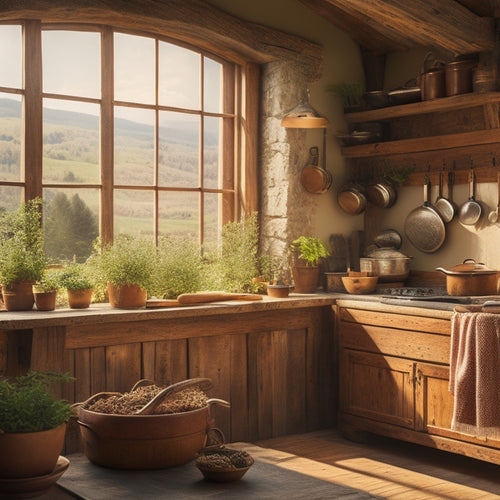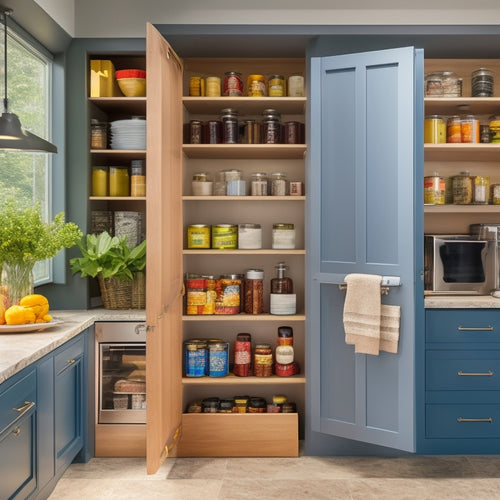
Illuminate Your Kitchen: Master Lighting Design Now
Share
Effective kitchen lighting design is a masterful blend of task, ambient, and accent lighting, crafting a harmonious space that's both functional and aesthetically pleasing. Understanding the fundamentals of lighting, from recessed to pendant fixtures, is essential for creating desired ambiance. Task lighting emphasizes targeted illumination, while ambient lighting sets the tone for a warm atmosphere. Balancing brightness and contrast is pivotal, as light temperature and shadow play can dramatically impact the space. By sidestepping common mistakes, you can curate a kitchen that shines – literally and figuratively. As you explore the world of kitchen lighting, the perfect design begins to take shape.
Key Takeaways
• Identify areas needing task, ambient, and accent lighting to create a well-planned kitchen lighting scheme.
• Balance task and ambient lighting to ensure safety, visibility, and a warm atmosphere.
• Consider light temperature, shadow play, and layered lighting to achieve visual harmony.
• Avoid poor lighting placement, neglecting color temperature, and sidestepping common pitfalls.
• Properly install lighting fixtures to ensure safety, functionality, and a visually appealing kitchen.
Understanding Kitchen Lighting Basics
Illuminating the kitchen space effectively begins with understanding the fundamental principles of kitchen lighting. This involves grasping the roles of different light sources, their placement, and the desired ambiance.
To achieve the best lighting, it's crucial to examine the layout of your kitchen and identify areas that require task, ambient, and accent lighting. Lighting placement plays a significant role in creating a safe and functional kitchen. For example, placing lights under cabinets or above countertops can provide task lighting, while installing pendant lights above the island can create ambient lighting.
Proper lighting installation is also essential to make sure that lights are securely fastened and meet safety standards. By understanding these basics, you can create a well-lit kitchen that is both functional and aesthetically pleasing.
Types of Lighting Fixtures Explained
With a vast array of lighting fixtures available, selecting the right ones for your kitchen can be a challenging task, but understanding the characteristics and applications of each type is essential to creating a harmonious and functional lighting scheme.
When choosing lighting fixtures, consider the following types:
-
Recessed Lighting: Ideal for task lighting, recessed lights are installed into the ceiling, providing focused illumination without visual obstruction.
-
Pendant Lighting: Suspended from the ceiling, pendant lights offer ambient lighting and can be used to create a stunning visual statement.
-
Under-Cabinet Lighting: Placed under kitchen cabinets, these fixtures provide task lighting and can be used to create a warm, inviting atmosphere.
Designing for Task and Ambient
At the heart of a well-planned kitchen lighting scheme lies the harmonious balance of task and ambient lighting, where focused illumination meets soft, warm glow.
Task lighting tips emphasize the importance of placing light sources close to work areas, such as under-cabinet lighting for countertops and pendant lights above islands. This targeted illumination guarantees safety and visibility while performing tasks.
Ambient lighting techniques, on the other hand, create a warm and inviting atmosphere, making the space feel cozy and relaxing.
Balancing Brightness and Contrast
In a well-crafted kitchen lighting design, balancing brightness and contrast is crucial to create visual harmony, as it allows the eye to move seamlessly between different areas of the space.
To achieve this balance, consider the following key factors:
-
Light temperature: Warm white light (2700K-3000K) creates a cozy atmosphere, while cool white light (3500K-4100K) enhances task visibility. Mixing light temperatures can generate visual interest.
-
Shadow play: Strategically positioned light sources can produce appealing shadows, adding depth and dimension to the space. Be mindful of harsh shadows that may result in unflattering lighting.
-
Layered lighting: Combine overhead lighting, under-cabinet lighting, and task lighting to achieve a balanced visual effect. This layered approach guarantees that each area of the kitchen receives the proper amount of light, minimizing harsh contrasts and creating a secure and welcoming environment.
Avoiding Common Lighting Mistakes
Crafting a kitchen lighting design that shines requires sidestepping common pitfalls that can leave a space looking dull, uninviting, or even hazardous.
One common mistake is poor lighting placement, where fixtures are installed too close or too far from task areas, creating harsh shadows or inadequate illumination.
Another error is neglecting to contemplate color temperature, which can greatly impact the ambiance and functionality of the space. Warm white lighting (2700K-3000K) can create a cozy atmosphere, while cool white lighting (3500K-5000K) can enhance task visibility.
Frequently Asked Questions
Can I Use Smart Lighting Systems in My Kitchen Remodel?
When incorporating smart lighting systems into your kitchen remodel, consider energy-efficient options with advanced features like dimming, color temperature adjustment, and scheduling, ensuring a safe and visually appealing space that aligns with your desired design aesthetics.
How Do I Choose the Right Lighting for My Kitchen Island?
"In the era of candlelit kitchens, we've come a long way; now, choosing the right lighting for your kitchen island means deciding between pendant vs. recessed lighting, and task vs. ambient lighting, to create a safe and visually stunning space that's both functional and beautiful."
Are LED Lights Worth the Higher Upfront Cost?
Considering LED lights' higher upfront cost, they offer substantial energy savings, increased longevity, and an environmentally friendly option, while also providing a wide range of color options, ensuring a safe and visually appealing kitchen ambiance.
Can I Install Kitchen Lighting Fixtures Myself?
When considering DIY installation of kitchen lighting fixtures, it's essential to prioritize safety precautions, guaranteeing a thorough understanding of electrical wiring and troubleshooting tips to avoid potential hazards and guarantee a successful, risk-free project.
How Do I Ensure Lighting Is Safe Around Kitchen Water Sources?
As you navigate the ocean of kitchen design, secure safe harbor by installing waterproof fixtures and implementing safety measures around water sources, adhering to electrical codes and prioritizing moisture resistance to avoid electrical shocks and fires.
Related Posts
-

Rustic Hanging Racks for Country-Style Kitchens
Rustic hanging racks are a game changer for your country-style kitchen, blending functionality with charm. They maxim...
-

Under-Sink Storage Bins for Organized Kitchens
Under-sink storage bins are your best bet for an organized kitchen. They maximize unused cabinet space and enhance it...
-

Affordable Sliding Pantry Drawer Solutions
If you're looking for affordable sliding pantry drawer solutions, you're in the right place. These drawers maximize s...


